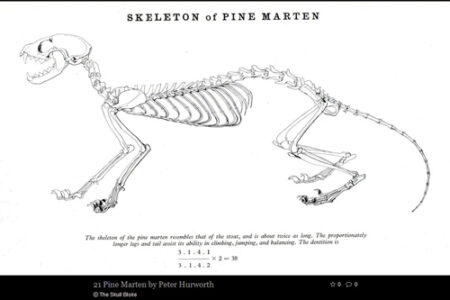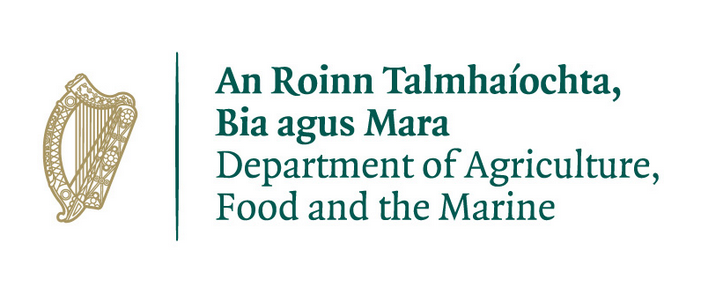
Pine Marten
Martes martes - Cat Crainn
Rehabilitation of wildlife casualties requires a licence and a large investment of time and resources. It is mainly in the animal’s best interest to transfer it to an appropriately trained and equipped individual/organisation as soon as possible.
Before attempting to capture a wildlife casualty:
- Observe, assess, discuss, then decide whether intervention is appropriate
- All wild animals can potentially transmit disease and inflict serious injuries
- Remember, your own safety is of paramount importance
HELP NEEDED
- Road traffic accident casualty
- A pine marten that will allow you to approach it is usually sick
- Damaged limb/s
- Obvious wounds
- If it is in danger e.g. from dogs/machinery
- Pine marten kit that still has eyes closed or is crawling unsteadily (under 12 week of age)
- Trapped or caught e.g. in fence – do NOT cut free and release until fully assessed
(NB; a trapped animal will display a high levels of aggression) - If unresponsive/unconscious – needs veterinary attention immediately
HELP NOT REQUIRED
- If you are not equipped
- Healthy adult pine marten in garden
- If you or others would be put in too much danger
IT DOES NEED RESCUING, WHAT NEXT?
FIRST try to call relevant contact number from CONTACT page for further advice, if unavailable try calling a vet from the CONTACT page
WANT TO ATTEMPT CAPTURE
- Follow capture instructions below
- Capture ONLY if you have adequate equipment and container
- Consider personal safety on roads e.g. reflective jackets, warning signs
- Bring to a vet if possible, if not bring home temporarily
- Follow husbandry advice for feeding and housing
- Call relevant contact number from CONTACT page for further advice
DON’T WANT TO ATTEMPT CAPTURE
- If you can approach the animal lay a blanket/coat over the casualty for warmth, cover head
- If animal is on the road, protect it from traffic if possible
- Consider personal safety on roads e.g. reflective jackets, warning signs
- If unconscious – do not drag the animal off the road, IF safe to do so, lift it to a safe place on a coat/towel
- Note exact location and call relevant person from CONTACT page
- Ideally stay with the casualty until someone comes to help
Capturing and restraining an injured or ill animal is extremely stressful, and your primary goal is to reduce stress by minimising pain and distress
Equipment
A thick blanket, gauntlet type gloves, long-handled net, soft-headed broom, dog grasper,
sturdy mesh cat crush cage or rigid wire mesh container or feral cat trap
Ideally at least 2 people
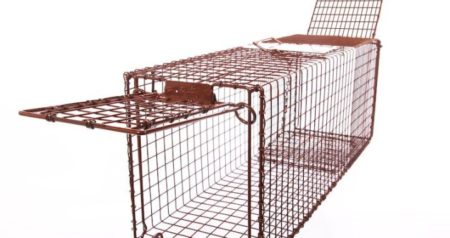
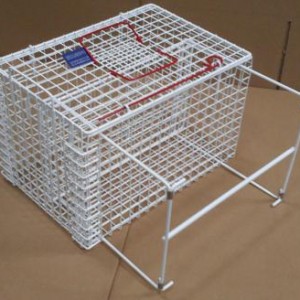
Caught in snare
- Dog grasper slid over the head and one front leg and tightened
- DO NOT CUT FREE AND RELEASE! (need to rule out underlying injuries from snare)
- Person two cuts wire so animals can be rescued, along with any embedded snare section
- The container must be large enough to fit pine marten and any embedded snare
- Pine marten pulled/lifted into open container (support rump by scruffing it as you lift)
- Container closed, grasper released and carefully withdrawn WITHOUT letting pine marten out
Unconscious casualty capture (e.g. hit by a car on-road)
- If an animal lying as if unconscious, poke gently with a stick/brush to check for movement
- If no movement, still handle with great care as handling could bring it back to consciousness
- Put a towel overhead
- Scruff tightly with both hands and lift into an open waiting container
OR..
- Put a towel over head. With thick gloves roll the animal onto the blanket, lift and tip into an open waiting container
Trap capture (if mobile)
|
|
Capture notes
Consider personal safety on roads: reflective jackets, warning signs etc
Crouch down when approaching – you appear less of a threat
Approach slowly, stopping if the animal appears ready to flee
TRANSPORTATION
Sturdy carrier – wire mesh or solid container with a secure lid, ideally a mesh crush cage from the vet
Dog carrier/puppy crate
Ventilation
Avoid direct sunlight – the danger of overheating
Cover container with a towel, darkness will reduce stress
HANDLING
Do not handle unnecessarily
Once captured do not try to calm the animal by talking to it
Keep other domestic animals out of sight
See SUPPLIERS page for food and equipment mentioned below
Housing
Are VERY destructive, will bite and chew. If teeth damaged, animal may be un-releasable
Escape artists!! Will climb out of any container if not fully enclosed
Cage must be large enough for animal to stand up and turn around in
House in quiet area away from domestic animals and children
Darken the container to reduce stress
Bedding can be straw or hay if obtainable, otherwise line container with newspaper
Ideally solid walls! concrete, stone, thick wood, rigid plastic
Suggestions:
- Dog cage/crate from the vet
- Building site mortar tub, with lid (remember ventilation)
- Empty deep water tank, with lid
- Empty deep wheelie bin in an emergency!
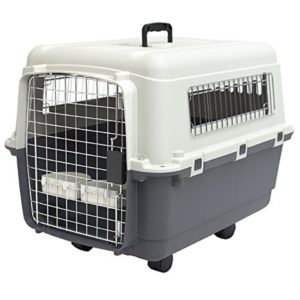
Warmth
If pine marten is very sick and unresponsive; wrap in warm towels
Place the cage in a warm area indoors
Feeding
Tinned dog/cat food as emergency short term food
Heavy bowl of drinking water if animal bright and alert
See SUPPLIES page for food and equipment mentioned below
Step by Step:
|
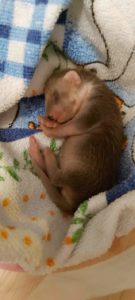 |
| Pine Marten Kit |
Housing – kit
House in cage as for adult above
Use towels on top of newspaper for bedding
Keep indoors, in a quiet darkened place, away from children and domestic animals
Only handle for feeding
Weighing
Young kits can be weighted on digital kitchen scales
Warmth
Kit needs to be dry and feel warm to the touch
Warm-up slowly with warm towels if very cold
Ambient heating is best so ideally place the cage in a warm room. Use a heat pad/heat mat for very young kits. Heat lamps can also be used for this purpose.
Beware overheating can also kill so give enough space that the kit can move away from the heat if necessary.
If the kit is cold it will be unwilling to feed
Toileting
VERY IMPORTANT!
Very young kits (under 3 weeks of age) need help urinating and defecating
Toilet at regular intervals: 2 hourly initially, moving to longer intervals as dictated by the animal
Before and after each feed gently stroke their genital and anal area with damp cotton wool until urine and/or faeces is produced
Toileting seems to act as a stimulant to start suckling
FEEDING
Rehydration solution/ ‘milk’ suggestions:
- Rehydration solution – “1 pinch of sugar and 1 pinch of salt in 1 cup of warm water”
- Feline milk replacement e.g. Royal Canin Kitten Milk
ALL feeds should be lukewarm
(24hrs of rehydration solution feeds is fine if alternatives are not possible)
Only handle for feeding (for frequency see below)
DANGER – Aspiration Pneumonia – inhaling fluid into the lungs
If a bubble of liquid appears at the nose or the kit starts sneezing or shaking its head, stop feeding immediately and tilt the head down to allow any fluid to drain out. Dab with tissue, take a break and then start again very slowly
Preventative measures:
- Use rehydration solution for the first few feeds while you and the kit get used to feeding
- Hold the kit vertically or lie on its belly whilst feeding
- Always feed patiently, slowly and gently
- Try to get the kit to lick/suck the fluids slowly rather than guzzling
Take to vet for antibiotics and other respiratory drugs if kit inhales fluids and starts coughing for an extended period of time, breathing heavily or breathing with mouth open
Introducing ‘milk’
1st feed – rehydration solution
2nd feed – ½ rehydration solution, ½ milk (Royal Canin Kitten Milk)
3rd feed – ¼ rehydration solution, ¾ milk
4th feed – milk
If the kit starts having diarrhoea or disimproves when milk is introduced then reduce milk formula, increase rehydration solution, and then gradually begin to increase milk content
Faeces
Good – scats (faeces) varies tremendously but they tend to be dark in colour and 4-12cm long x 0.8-1.8cm in diameter. They often have a coiled and twisted appearance
On milk formula, faeces will be ??
Bad – pale, runny, watery ??
Seek veterinary attention if unsure or worried
If using milk formula then change back to rehydration fluids for 24hrs
Sterilise all feeding equipment
Once faeces look normal again, slowly reintroduce milk formula
Bottles/equipment
- Syringe with teat but be aware of aspiration pneumonia (mentioned above) and feed very slowly watching to check that the kit swallows as you feed
- Kitten feeding bottle
Quantity &Frequency (ROUGH guide)
| Weight | Approximate age | Quantity per feed | Frequency |
| 70 – 80 g | 2 weeks | 7 – 8 ml | ?? feeds per day |
| 180 – 200 g | 4 weeks | 18 – 20 ml | ?? feeds per day |
| 600 – 650 g | 7 weeks | weaning 60 – 65 g | ?? feeds per day |
Theoretically, kits may be fed up to 10% body weight per day, depending on appetite
The table above is a ROUGH guide, each individual is different
Never feed an animal so much fluid that its tummy becomes hard and distended
Frequency
If very young, especially if eyes still closed, feed 2-3 hourly, through the day and 4hourly during the night ??
If older and lively feed every 4hrs during the day, last feed 10 pm, first feed 5 or 6 am??
If they are unwilling to wake up and feed, extend the gap between feeds by ½ hour
Hygiene
Keep feeding utensils in a deep bowl of sterilising solution e.g. Milton
Use clean feeding utensils for each feed
After use, dismantle feeding equipment and clean thoroughly in warm soapy water, rinse, then replace in the sterilising bowl
Rinse utensils before each feed
Rehabilitation of wildlife casualties requires a licence and a large investment of time and resources. It is mainly in the animal’s best interest to transfer it to an appropriately trained and equipped individual/organisation as soon as possible.
Before attempting to capture a wildlife casualty:
- Observe, assess, discuss, then decide whether intervention is appropriate
- All wild animals can potentially transmit disease and inflict serious injuries
- Remember, your own safety is of paramount importance
Housing
Escape artists!, can dig and squeeze through TINY gaps
Ideally outdoor run with nest box:
- Solid sides e.g. brick, metal, to a height of 1metre then weldmesh fencing above that to head height. Mesh or concrete floor
- Or ideally 6 sided galvanised heavy duty weldmesh enclosure (see photo below)
 |
 |
Include one Nest Box per pine marten approx 1.5 meters above ground level for shelter (designs available on Vincent Wildlife Trust website)
Straw or hay for bedding
Fresh water for drinking
Big leafy branches for hiding, enrichment, and to reduce stress
Located in quiet area away from domestic pets
| FeedingA wide variety of food is best for optimal health and nutrition. Fruits, unsalted nuts, berries, quail, day old chicks, mice, rabbit and chicken can be used Supplements can be inserted into the food as required Heavy shallow bowl of drinking waterIf feeding quail give one and a half per day, a raw egg and some fruit and nuts If feeding chicks give between 5 – 6 with the above egg, fruit and nutsAdult martens can eat about 140-160g food per night: about 10% of body weightOnce in the morning and once in the afternoon. Scatter feeding can improve environment enrichment. |
 |
Hand-rearing should not be undertaken unless:
- IT CAN QUICKLY BE PLACED WITH OTHER KITS IN A SOCIAL GROUP FOR RELEASE
(Email <info@irishwildlifematters.ie> if you acquire an orphan, you will be put in touch with other orphan carers)
- The kit will be kept as wild as possible
- Suitable accommodation facilities will be provided
- It is understood that it will require care until it is 4-6 months of age
- It is understood that rearing and successful release of a pine marten requires considerable expertise, money and specialised pre-release accommodation
Extra info for long term husbandry:
Housing – kit
Most importantly- warmth and quiet
Keep indoors, away from children and domestic animals
Use a sturdy pet carrier/ puppy crate until they are old enough that they start moving around
Once they’re feeding for themselves and lively move to outdoor accommodation
| Warmth If eyes are still closed, or very sick, the kit needs to be kept warm; ideally in a container with an ambient temp of roughly 25˚C Beware overheating can also kill – monitor carefullyWeight When young and bottle feeding weigh daily Weigh at the same time each day Weight loss or static weight can be an early indicator of underlying problems |
 |
|
© Chelsea Collins
|
Young kits can be weighted on a digital kitchen scales
Older kits and adults can be placed into a pillow case and the pillow case hung on a spring loaded scales to get body weight
Development in the wild
Birth: March/April, blind and deaf, whitish fur, 30g
2-3 weeks: start crawling
5-6 weeks: eyes open
7 weeks: deciduous teeth erupted, weaning, increasing activity levels
8 weeks: eating solids
12 weeks: out of den and very active. full adult coat, middle of June
4 months: permanent dentition erupts, leave nest late June/early July
6 months: fully independent, disperse in autumn
Sexual maturity: 2-3yrs
Mating July-August
Delayed implantation 5-7 months
Active gestation following implantation 30 days
Feeding
Rehydration solution – Lectade or equivalent
Ideally a half and half mixture of ‘Multimilk’ and ‘Milk Matrix 30/55’
Canine milk replacement e.g. Esbilac or Lactol
Bottles/equipment
- Syringe with teat for very young kits
- Royal canin puppy/kitten nursing bottle
Weaning
At aprox 7 weeks, when lively and teeth have come through
Encourage to drink from bowl, once kit learns, always keep fresh water available
When teeth appear, introduce small pieces of raw minced chicken/rabbit/meat
Over the course of several weeks, gradually reduce milk formula and increase solids
Finally feed only meat/fruit/solids
Records
Routine records should be maintained of daily weight, times of each feed, quantities of food consumed, urine/faeces production and general condition/demeanour
Imprinting
Easily done, potentially prevent release
Always try and rear more than one of a species together (not doing so will produce abnormal and dangerous behaviour)
Keep away from smells and noises of companion and domestic animals
KEEP HUMAN CONTACT TO ABSOLUTE MINIMUM
| Potential problem Odd behaviour has been recorded in pine martens living in captivity such as males attempting to mate with individuals of the same sex. This may be linked with stress of captive life. Stereotypical behaviours can occur in animals living in captivity over a prolonged period of time. Enrichment can reduce onset of such behaviours |
 |
Always seek advice from specialist organisations with knowledge of suitable release sites/habitat
Careful assessment and appropriate health checks should be carried out prior to release, as to the risks of released animals introducing new diseases into the wild population/environment.
Release criteria/considerations
Need to be wild – scared of humans, domestic animals and any other natural predators
Must be physically fit, mentally sound, stable body weight for over 7 days
Can’t be released if underweight, unable to recognise/eat normal diet etc
Must be of an appropriate weight for the age, sex, and time of year for the species
Do not release in winter unless it has sufficient body weight to cope with the cold
Ideally return to original location unless dangerous or unsuitable
Release away from roads, species specific predators, areas where they could cause damage
Consider natural history of the animal and the location of local wild groups of these animals
Release during a period of favourable weather.
Ideally identify animal in some way e.g. microchip/tag, for post release monitoring/identification
 |
 |
|
sedated marten with VHF collar
|
Preferred habitat
mainly found in coniferous or deciduous woodland or scrub with good ground cover
HARD RELEASE (direct release)
Adults
Hard release technique
The animal is simply allowed to exit a transport container with no further care or feed provision.
Hard release candidates
Hard release technique only suitable if animal rescued as an adult and only if in captivity for short period of time, and only if to be released where originally found.
Release timing
Release adults as soon as possible
Species specific considerations
Release habitat must have an adequate food supply to accommodate successive groups of pine martens over several years.
Ensure area not susceptible to pollution problems.
Avoid conflict areas e.g. farms/game keepers
Investigate acceptance of the release by landowners/game keepers
Within a sub-optimal pine marten population
Technique
Ideally return to exact location animal was rescued
Open carrying cage and let animal leave in its own time
Release at dusk
SOFT RELEASE (gentle or gradual release)
Kits (sometimes adults)
Soft release technique
Soft release aims to slowly reintroduce the animal to the wild while still in a comfort zone e.g. cage it was reared in, and allow the animal to leave the cage once confident and independent.
It involves continuing to care for animals at the release site, and aims to compensate for difficulties of newly released animals finding food and shelter in a new environment.
Soft release candidates
Essential release method for hand reared animals.
If more than one young animal in care, if practicable, try to form a release group.
Release group – try to have mixed genders, appropriately matched age group.
Also suitable for adults that have been in care for a long period of time, or animals that cannot be released back to where they were found and so have to establish a new territory.
Release timing
When food is abundant – summer/autumn
When kit is fully independent – 5-6 months
As SOON as adult is fully recovered
Species specific considerations
Release habitat must have an adequate food supply to accommodate successive groups of pine martens over several years
Ensure area not susceptible to pollution problems
Avoid conflict areas farms/game keepers
Investigate acceptance of the release by landowners/game keepers
Within a sub-optimal pine marten population
Technique
Temporary cage placed in release location
Their own familiar sleeping box/artificial nest box placed within caged area, kit provided with water and food at dusk, in the enclosure, for 2-4 weeks.
Animal fed only natural foods it will come across in the wild
Cage opened one evening and left in-situ for animal to come and go until it feels confident enough not to return.
Food provided, decreasing in quantity, until the animal no longer returns
Soft release may take a few days – a few weeks
 |
 |
“The Minister may grant a licence to a person to have in possession, for a reasonable period of time —
- an injured or disabled protected wild animal, or
- one or more than one dependent young of a protected wild animal which is orphaned, with the intention of tending and later releasing such animal or young back into the wild when and only when such animal or young, as the case may be, is no longer injured, disabled or dependent, or
- to retain possession of a protected wild animal, that for reasons of disability or for other reasons deemed reasonable by the Minister, would, if released, be unlikely to survive unaided in the wild.”
*Compulsory licence details at end of document*
PINE MARTEN
Status
Irish Wildlife Act 1976 and Wildlife (Amendment) Act 2000 – protected species
Berne Convention, Appendix 3 – requires strict protection
EU Habitats Directive, Annex 2 and 4 – of European interest
IUCN Red List least concern
Wildlife (N.I.) Order of 1985 – protected species
Irish Red Data book – Least concern
Wildlife and Countryside Act (1981) and the Environmental Protection Act – full protection
Exemptions
The Minister may grant a licence to capture or kill for educational, scientific or other purposes
Safeguards
May not be hunted or killed or their breeding places disturbed
Rescue and Rehabilitation
Due to their status as a protected species, a *licence MUST be applied for to the NPWS ‘to possess/retain an injured or disabled wild animal
Release
Subject to the conditions set out in the licence provided for the possession/retention of the wild animal
Notes
Report suspicious activities or equipment to the NPWS Conservation Ranger (see CONTACTS page)
* For licence application form for the possession/ retention of a wild animal – click HERE
Post to the address below OR email to wildlifelicence@ahg.gov.ie
Wildlife Licensing Unit,
National Parks and Wildlife Service,
Department of Arts, Heritage and the Gaeltacht,
7 Ely Place,
Dublin 2.
Phone: (01) 888 3242
This legislation section is not intended to cover all aspect of legislation associated with this particular wildlife species, in all instances, the current legislation and appropriate statutory bodies should be consulted
Canine distemper virus
Clinical Signs – fever, appetite loss, congested sinuses, bloody diarrhoea
Diagnosis – blood sample
Treatment – fluids then antibiotics and B vitamins
Comments – virus shed in urine faeces and saliva, viable up to 6mths
Clinical Signs – commonly fractures, sometimes ruptured diaphragms, livers or spleens, in-coordination, disorientation, temporary blindness |
 |
|
© Offaly SPCA
|
- Bite wounds
Clinical Signs – heat, swelling, pain, puncture wound or laceration, abscess.
Diagnosis – clinical signs or culture
Treatment – if abscess; drain and treat as open abscess. Fluids as for shock. Broad spectrum antibiotics. Corticosteroids for endotoxaemia. Regular flushing of wound
Fresh open clean wounds – clip, clean and suture if necessary. Use subcuticular suturing and absorbable suture material
Comments – likely to be infected, possibly septicaemic
- Snare injuries
Clinical Signs – injury to the limb, chipped teeth from chewing at it, underlying tissue damage
Diagnosis – ligature marks, snare attached, history
Treatment –remove snare under GA. Analgesics and antibiotics. Aggressive fluid therapy
Comments – keep for at least 7 days to monitor for pressure necrosis or self mutilation
- Ticks (Ixodes hexagonus) Fleas and Lice
Clinical Signs – visual identification
Diagnosis – clinical signs
Treatment – removal
Comments – often on the neck and behind the ears, lice around groin and head
- Demodex mites
Clinical Signs – dry alopecia and thickening of the skin or red, pustules and wrinkling of the skin
Diagnosis – clinical signs, microscopy
Treatment – ivermectin along with improved nutrition and addressing any possible underlying immune system-suppressing diseases and any secondary bacterial infections
Comments – demodicodic lesions are found on the face, muzzle, forelimbs and periorbital regions
- Nematode – Skrjabingylus nasicola
Clinical Signs – in heavy infections, subadult worms may invade the brain and cause neurologic signs, including paralysis
Diagnosis – mainly post mortem
Treatment – nematicides
Comments – larvae acquired from terrestrial snails and slugs, can eventually penetrate the animal’s skull (cribriform plate)
- Cryptosporidiosis
Clinical Signs – acute, watery, and non-bloody diarrhoea
Diagnosis – serological tests and microscopic evaluation of oocysts in faeces
Treatment – supportive therapy such as IV fluids
Comments – cryptospondium parvum infection is generally self-limiting
- Dental disease
Clinical Signs – inflamed, bleeding gums, mouth pain, emaciation, bad breath, drooling
Diagnosis – clinical signs
Treatment – symptomatic
Comments – with all animals, mouth should routinely be checked. Cannot be released if damage results in canines needing removal
- Hydrocephalus
Clinical Signs – rounded cranium, in coordination
Diagnosis – clinical signs, radiography
Treatment – none
Comments – in kits, euthanasia recommended
- Hypothermia
Clinical Signs – lethargy, temperature below 37.5˚C
Diagnosis – abnormally low temperature
Treatment – warm up slowly and monitor carefully to prevent hyperthermia
Comments – common due to inactivity if ill/injured
- Orphan
Clinical Signs – do not normally leave the den until after 12wks of age, should be aprox 1kg at this age. Orphan kits mainly found end May, start June
Diagnosis – alone above ground before mid/end June weighing less than 1kg
Treatment – see husbandry section for kit on rehabilitators page
Comments – definatly orphaned if you are able to catch it! or as in scenario below
 |
 |
|
© Offaly SPCA
|
© Offaly SPCA
|
Candidates
- No quality of life when recovered
- Amputation necessary
- Hydrocephalus
Drug
- Pentobarbital sodium
Technique
- Deep sedation then IP injection
| SC | between shoulder blades |
| IM | quadriceps or lumbar |
| IO | femoral marrow cavity |
| IP | posterior to umbilicus, needle angled cranially |
| IV | jugular, cephalic |
| PO | in food |
| Temperature (°C) | 37 |
| Pulse rate (beats per minute) | |
| Respiratory rate (breaths per minute) |
| Care with hygiene handling all wildlife Ideally observe discreetly before examination; wildlife hide injuries Sedation sometimes the only way of examining adult pine marten, use crush cage if necessaryAlways muzzle when handling, even after sedation or if animal appears to be unconscious Muzzling difficult due to short snout, temporary tape muzzle more appropriate Sharp front claws must be restrained Try not to change grip when handling |
 |
|
© Offaly SPCA
|
- Weigh
- Warm up
- If baby pine marten; stimulate to urinate/defecate
- Fluids
- Drugs
RTA casualties will often be suffering volume related shock, treat as below
TREATMENT FOR SHOCK
- Warmth (stop animal loosing heat, warm slowly)
- IV fluids – Hartmann’s or Haemaccel
- Oxygen as required
- Analgesia (if head trauma do not use buprenorphine, finadyne or carprofen)
Antibiotics if appropriate
After treatment for shock, attend to conditions that are life threatening or could worsen over 24hrs
Assess every few hours. As soon as stable, examine thoroughly, and decide on a treatment plan or euthanise as appropriate

